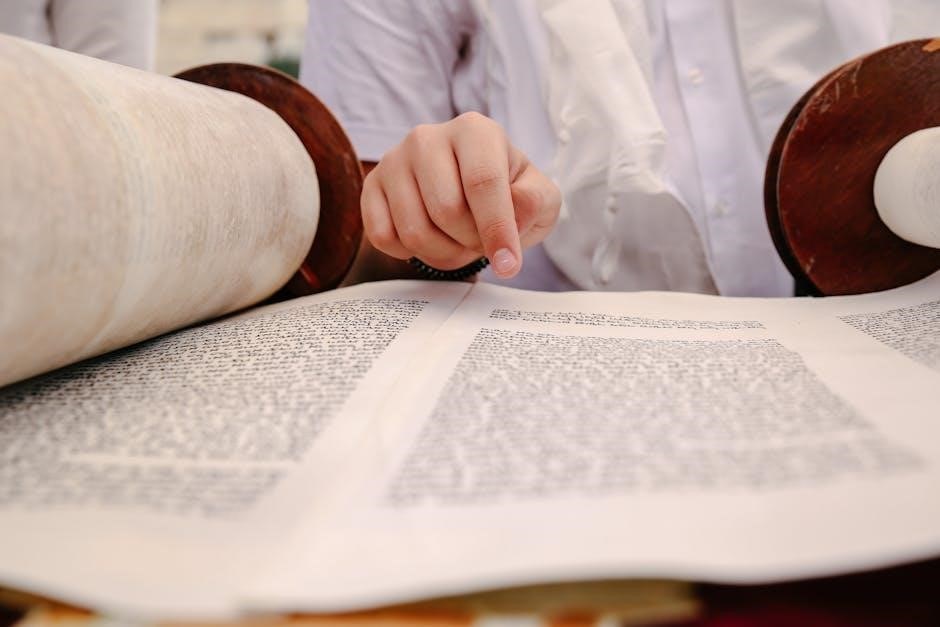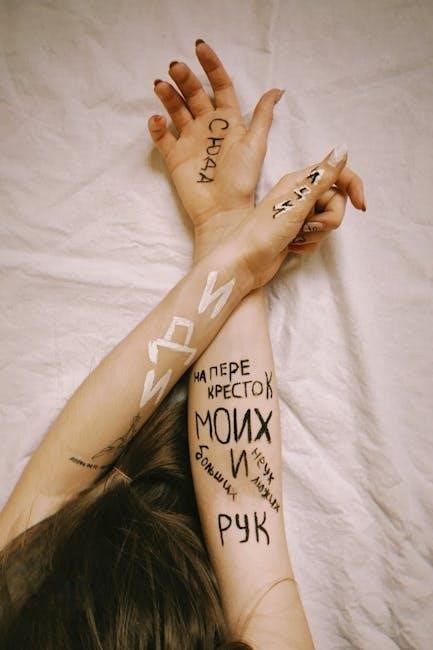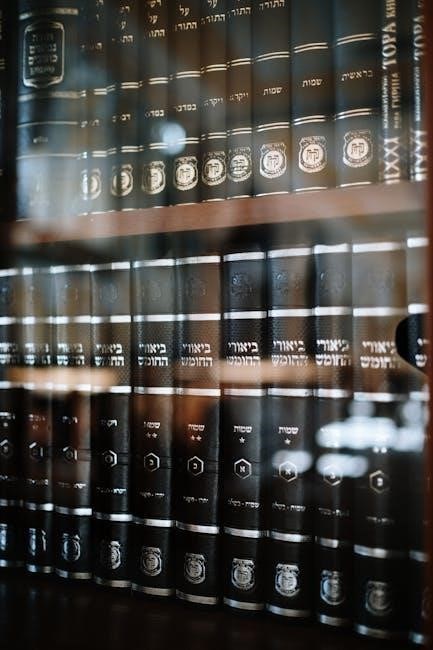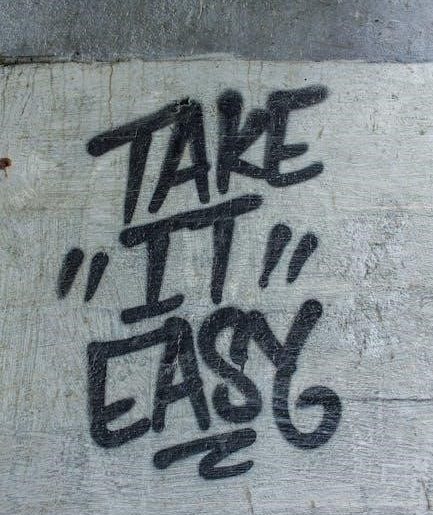The Hebrew alphabet consists of 22 letters, each carrying unique meanings and spiritual significance. This guide explores their historical roots, linguistic structure, and profound symbolism, offering a deeper understanding of their role in Jewish tradition and culture.
Overview of the 22 Hebrew Letters
The Hebrew alphabet comprises 22 letters, all of which are consonants, written from right to left. Five of these letters—Kaf, Mem, Nun, Pei, and Tzadi—have distinct final forms when appearing at the end of a word. Each letter carries unique meanings and symbolism, rooted in ancient pictographs, such as Alef representing an ox and Bet symbolizing a house. These letters also hold numerical values, known as Gematria, adding layers of interpretation in Jewish texts. The alphabet’s structure reflects its historical evolution, blending practical use with profound spiritual significance. Understanding these 22 letters provides insight into the language’s linguistic and cultural depth, making it a cornerstone of Jewish tradition and identity.
Significance of the Hebrew Alphabet in Jewish Tradition
The Hebrew alphabet holds profound spiritual and cultural significance in Jewish tradition, often viewed as a divine gift from God. Each letter is believed to contain divine energy and deeper meanings, as taught in Kabbalah. The letters are central to the Torah, the foundational text of Judaism, and their shapes and sounds are considered sacred. The alphabet’s 22 letters are not just a means of communication but also symbols of Jewish identity and heritage. Their numerical values, or Gematria, are used to uncover hidden meanings in texts, adding layers of interpretation. The Hebrew alphabet is also integral to Jewish rituals and education, such as Bar and Bat Mitzvahs, where its mastery is a rite of passage.

Structure and Pronunciation of the Hebrew Alphabet
The Hebrew alphabet is composed of 22 letters, all of which are consonants. Unlike English, it is written from right to left, and its structure is unique in that it originally lacked vowel letters. Instead, vowel sounds were indicated by niqqud, a system of dots and lines added above or below the consonants. Each letter has a distinct pronunciation, and some letters change their form when appearing at the end of a word. For example, five letters—Mem, Nun, Tzadi, Peh, and Kaf—have special final forms. The pronunciation of these letters remains consistent, but their written appearance differs. This dual structure adds complexity and depth to the alphabet’s functionality and aesthetic appeal.

Historical Development of the Hebrew Alphabet
The Hebrew alphabet originated from the Paleo-Hebrew script, heavily influenced by Phoenician writing. Over centuries, it evolved into the distinctive square script used today.
Ancient Hebrew Script (Paleo-Hebrew)
The Paleo-Hebrew script, also known as Ktav Ivri, is the earliest form of the Hebrew alphabet. It closely resembles the Phoenician writing system, with no distinction between final and initial letter forms. Each letter often symbolized an object or concept, such as “aleph” representing an ox. This script was used from the 10th century BCE until the Babylonian exile, after which it was gradually replaced by the Aramaic script. Paleo-Hebrew’s significance lies in its connection to ancient Israel’s cultural and religious roots, with some letters later evolving into the modern Hebrew alphabet while retaining their original meanings.
Evolution of the Hebrew Alphabet Over Time
The Hebrew alphabet has undergone significant changes over centuries. Originating from the Paleo-Hebrew script, it evolved into the Aramaic-based “Ktav Ashuri” after the Babylonian exile. By the 7th–10th centuries CE, the Masoretes added vowel points, enhancing pronunciation clarity. Modern Hebrew retains 22 letters, with five letters (“Mem,” “Nun,” “Tzadi,” “Peh,” and “Kuf”) having distinct final forms. Over time, the script’s aesthetic and usage adapted to cultural needs, such as in liturgical texts and secular media. This evolution reflects Hebrew’s enduring role as a bridge between ancient tradition and contemporary life, preserving its historical essence while embracing new purposes.
Spiritual and Mystical Meanings of the Hebrew Letters
Each Hebrew letter holds unique mystical meanings, symbolizing concepts like creation, divine attributes, and the universe’s structure. Rooted in Kabbalah, they reveal profound spiritual truths and inner wisdom.

Kabbalistic Interpretations of the Letters
Kabbalistic interpretations delve into the esoteric meanings of the Hebrew letters, viewing them as vessels for divine energy. Each letter is associated with specific spiritual attributes, numerical values, and cosmic influences. For instance, Alef, the first letter, symbolizes the unity of creation, while Beit represents the divine “house” or the physical world. These interpretations are deeply tied to the structure of the universe and the nature of the human soul. Kabbalists study the letters to uncover hidden truths, believing they hold the keys to understanding the divine plan and the interconnectedness of all existence. This mystical approach transforms the alphabet into a tool for spiritual growth and self-discovery.
Symbolism and Numerical Values (Gematria)

The Hebrew alphabet is deeply intertwined with symbolism and numerical values, a practice known as Gematria. Each letter represents a specific number, with the first ten letters corresponding to numbers 1 through 10, and subsequent letters assigned values like 50, 100, and so on. These numerical values allow for intricate calculations, uncovering hidden meanings in words and phrases. For example, the letter Alef (א) symbolizes an ox, representing strength and leadership, while Beit (ב) signifies a house, embodying structure and home. Gematria is used to explore connections between words, phrases, and ideas, offering profound insights into biblical texts and Jewish tradition. This system transforms the alphabet into a tool for decoding spiritual and philosophical truths.
Practical Uses of the Hebrew Alphabet Today
The Hebrew alphabet remains vital in modern times, used for religious practices, education, and cultural preservation. It connects communities to their heritage and facilitates language learning.
Hebrew as a Living Language
Hebrew is a vibrant, living language spoken by millions in Israel and Jewish communities worldwide. It serves as a bridge between ancient traditions and modern life. Hebrew’s revival in the 19th and 20th centuries transformed it from a liturgical language into a everyday tongue for education, media, and government. Its unique alphabet, with 22 consonants and vowel symbols, is central to its identity. Modern Hebrew incorporates ancient and contemporary vocabulary, adapting to technological advancements while preserving its historical roots. Learning Hebrew connects speakers to Jewish heritage and enables engagement with Israel’s dynamic culture. Its resilience reflects the enduring significance of the Hebrew alphabet in shaping identity and fostering communication across generations.

Use of Hebrew Letters in Religious and Cultural Contexts

The Hebrew letters hold profound significance in both religious and cultural practices. In Judaism, they are central to Torah study, prayer, and ritual objects like mezuzahs and tefillin. Each letter is imbued with symbolic meaning, reflecting spiritual and ethical concepts. Beyond liturgy, Hebrew letters inspire art, literature, and traditions. They are often used in Jewish names, carrying deep personal and cultural significance. The letters also feature prominently in Kabbalistic teachings, where their shapes and numerical values (Gematria) reveal hidden truths. Their presence in synagogue decor and ceremonial items underscores their enduring role in Jewish identity and heritage, bridging the ancient and modern worlds.

Cultural Significance of the Hebrew Alphabet
The Hebrew alphabet is a cornerstone of Jewish culture, symbolizing heritage and identity. Its letters are used in art, calligraphy, and historical texts, preserving traditions and values across generations.
Hebrew Calligraphy and Art
Hebrew calligraphy is a revered art form, blending aesthetic beauty with spiritual depth. Each letter, rich in symbolic meaning, is meticulously crafted to convey both linguistic and cultural significance. Traditional calligraphy often features intricate flourishes, while modern interpretations incorporate diverse styles, preserving the alphabet’s timeless elegance. The art form is deeply intertwined with Jewish heritage, appearing in sacred texts, ceremonial objects, and decorative pieces. From the meticulous writing of Torah scrolls to the elaborate designs on ketubot (wedding contracts), Hebrew calligraphy serves as a bridge between tradition and creativity, celebrating the alphabet’s enduring influence on Jewish identity and artistic expression.

Role of the Hebrew Alphabet in Jewish Identity
The Hebrew alphabet is a cornerstone of Jewish identity, serving as a symbol of cultural and religious continuity. It is deeply intertwined with Jewish tradition, education, and spirituality. From the study of Torah to the celebration of lifecycle events, the Hebrew letters are a constant presence, reinforcing a connection to heritage. The alphabet’s unique calligraphy and meaning-rich letters inspire pride and unity among Jews worldwide. Learning the Hebrew alphabet is often a rite of passage, particularly for children, fostering a sense of belonging to the Jewish community. Its enduring relevance ensures that the Hebrew alphabet remains a vital element in preserving and transmitting Jewish identity across generations.
